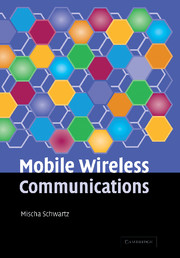Book contents
- Frontmatter
- Contents
- Preface
- 1 Introduction and overview
- 2 Characteristics of the mobile radio environment–propagation phenomena
- 3 Cellular concept and channel allocation
- 4 Dynamic channel allocation and power control
- 5 Modulation techniques
- 6 Multiple access techniques: FDMA, TDMA, CDMA; system capacity comparisons
- 7 Coding for error detection and correction
- 8 Second-generation, digital, wireless systems
- 9 Performance analysis: admission control and handoffs
- 10 2.5G/3G Mobile wireless systems: packet-switched data
- 11 Access and scheduling techniques in cellular systems
- 12 Wireless LANs and personal-area networks
- References
- Index
6 - Multiple access techniques: FDMA, TDMA, CDMA; system capacity comparisons
Published online by Cambridge University Press: 05 June 2012
- Frontmatter
- Contents
- Preface
- 1 Introduction and overview
- 2 Characteristics of the mobile radio environment–propagation phenomena
- 3 Cellular concept and channel allocation
- 4 Dynamic channel allocation and power control
- 5 Modulation techniques
- 6 Multiple access techniques: FDMA, TDMA, CDMA; system capacity comparisons
- 7 Coding for error detection and correction
- 8 Second-generation, digital, wireless systems
- 9 Performance analysis: admission control and handoffs
- 10 2.5G/3G Mobile wireless systems: packet-switched data
- 11 Access and scheduling techniques in cellular systems
- 12 Wireless LANs and personal-area networks
- References
- Index
Summary
We used the term “channel” rather abstractly in our discussion of FCA and DCA in Chapters 3 and 4. In this chapter we make the concept more concrete and provide examples of different types of “channels” used in current cellular systems. The word channel refers to a system resource allocated to a given mobile user enabling that user to communicate with the network with tolerable interference from other users. Channels are thus implicitly orthogonal to one another. The most common types of channels adopted for cellular systems are frequency channels, time slots within frequency bands, and distinct codes. These three different ways of providing access by multiple users to a cellular system are termed, respectively, frequency-division multiple access or FDMA; time-division multiple access (TDMA); and code-division multiple access (CDMA). We describe these different multiple access techniques in this chapter, using the three most widely deployed second-generation digital cellular systems as examples. All three of these systems utilize FDMA as well. Two of the systems, GSM and D-AMPS or IS-136, are TDMA-based systems; the third system, IS-95, uses CDMA. Since FDMA underlies all of the cellular systems to be discussed in this book, including the third-generation systems discussed in Chapter 10, we describe the FDMA concept briefly first. We then devote separate sections to TDMA and CDMA systems, ending the chapter with a comparison of their “channel capacities,” or the number of users each multiple-access scheme can accommodate per cell in a specified frequency band.
- Type
- Chapter
- Information
- Mobile Wireless Communications , pp. 137 - 160Publisher: Cambridge University PressPrint publication year: 2004
- 2
- Cited by



